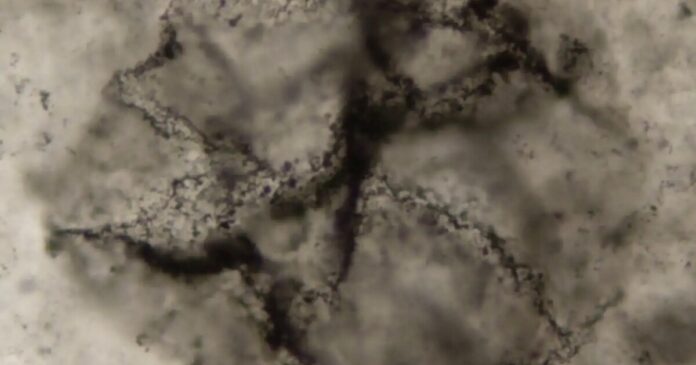Earth’s earliest life left behind very few chemical traces. Fragile remains, like ancient cells and microbial mats, were buried, squeezed, heated, and broken apart by the planet’s shifting crust before reappearing at the surface. These drastic changes erased most traces of how life began and evolved.
To study Earth’s earliest life, paleobiologists mainly depend on fossils. These include tiny remains of single cells and filaments, as well as mineralized traces of microbial mats and layered stromatolites. Such fossils show that life existed at least 3.5 billion years ago, but they are scarce.
Scientists also search for ancient biomolecules in rocks. Some of the hardiest molecules survive up to 1.7 billion years, and isotopes in older rocks suggest life 3.5 billion years ago. But most ancient rocks have lost these clues; heat and pressure shattered those molecules into tiny, uninformative fragments.
But now, using advanced chemistry and AI, a team of Carnegie researchers uncovered new chemical traces of Earth’s earliest life in 3.3‑billion‑year‑old rocks, and evidence that oxygen‑producing photosynthesis began over 800 million years earlier than thought.
The study builds on the idea that life selects molecules for specific functions, unlike what we see in meteorites or other non-living chemistry. Living cells make specific molecules in large amounts, each serving a role. The new work shows that even when ancient biomolecules are gone, the pattern of their fragments in old rocks can still reveal clues about past life.
The team analyzed 406 samples with organic molecules using pyrolysis gas chromatography and mass spectrometry. These included 141 ancient sedimentary rocks (from ~3.8 billion to 10 million years old), 65 fossil-rich samples like coal and oil shale, and 123 modern plants, animals, and fungi. They also studied 42 meteorites and 35 lab-made organic mixtures to compare living and non-living sources.
Out of the 406 samples, 272 fit into nine categories used for machine learning: Modern Animals – from recently deceased invertebrates and vertebrates; Modern Plants (non-photosynthetic tissues) – such as roots or flowers; Modern Plants (leaves) – green leaves and other photosynthesizing tissues; Sedimentary Rocks with Fossil Cyanobacteria/Algae, Fossil Wood – including coal; Animal Fossils – including fish and gastropod proteins; Modern Fungi – wood fungi and yeast; Meteorites – mainly chondrites; and Synthetic Samples – 35 lab-made organic mixtures.
The team used advanced spectrometry to isolate chemical fragments from the samples, then applied a “random forest” machine-learning model. This approach builds hundreds of decision trees to classify the data and uncover hidden biological patterns. This marks the first time supervised machine learning has been used to detect biosignatures in rocks billions of years old.
The model distinguished living organic matter from non-living sources with up to 98% accuracy. It identified signs of photosynthesis with 93% accuracy and separated plant-based life from animal-based life with 95% accuracy. Classifying ancient rocks is harder, though, because the training set has few animal fossils.
“These samples and the spectral signatures they produce have been studied for decades, but AI offers a powerful new lens that allows us to extract critical information and better understand their nature,” says first author Anirudh Prabhu. “Even when degradation makes it difficult to spot signs of life, our machine learning models can still detect the subtle traces left behind by ancient biological processes.”
Instead of just labeling samples as “life” or “non-life,” the model gave probability scores. Anything above 60% was considered a strong sign of life. This approach adds nuance – for example, coal heated above 400 °C (752 °F) might lose its biological signals and fall into the “uncertain” range. At the same time, well-preserved ancient samples still scored clearly in the “biotic” zone.
Three major findings emerged from the study. The first was the dating of organic molecules with photosynthetic origins in 2.52‑billion‑year‑old rocks from South Africa. This date is 800 million years earlier than any previously.
The second finding was tracing the biological origins of organic molecules in 3.51‑billion‑year‑old rocks from India. And finally, tracking the non‑photosynthetic origins of organic molecules in 3.5‑billion‑year‑old rocks from South Africa.
Another key result is that supervised machine learning can uncover biochemical clues in Paleoarchean samples, rocks so old and altered that no intact biomolecules remain.
“This study represents a major leap forward in our ability to decode Earth’s oldest biological signatures,” says Robert Hazen from Carnegie Science. “By pairing powerful chemical analysis with machine learning, we can read molecular ‘ghosts’ left behind by early life that still whisper their secrets after billions of years. Earth’s oldest rocks have stories to tell and we’re just beginning to hear them.
“Our results show that ancient life leaves behind more than fossils; it leaves chemical ‘echoes.’ Using machine learning, we can now reliably interpret these echoes for the first time.”
The study is published in the Proceedings of the National Academy of Sciences.
Source: Carnegie Science


